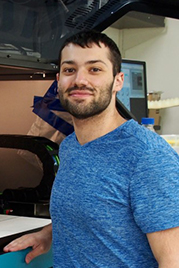Lab Members
Principal Investigator

Research Staff

Alanna M. Klose
Technical Associate
MC 5-8527
Phone: (585) 273-2149
Research Interest: Measuring circulating antibodies in human serum using arrayed imaging reflectometry (AIR), a label free multiplex optical biosensor.

Ethan Luta
Laboratory Technician
Research Interest: Development and synthesis of sorbent polymers for the detection of analytes of interest in the fields of medicine, agriculture, environment, and biological and chemical warfare agent detection. Incorporating sorbent polymers into our current sensing platforms will enable the improvement in the specificity and selectivity compared to current photonic sensing platforms.
Graduate Students

Chemistry Ph.D. Program
Research Interest: Expanding the chemical toolbox for RNA recognition: My research is devoted to developing a synthetic scaffold that will expand the known chemical space for RNA recognition efforts. This scaffold will be used to generate a Resin-Bound Dynamic Combinatorial Library to identify high affinity compounds for the C-C Chemokine Receptor type 5 (CCR5) mRNA, a coreceptor for HIV-1 for entry into CD4 T cells.

BME Biomedical Engineering Ph.D. Program
Research Interest: My research interests revolve around developing diagnostic technologies that are portable, rapid, cost-effective and capable of providing accurate results at the point of care, enabling timely disease detection, and improving healthcare accessibility. I am currently developing enzyme free methods for HIV detection at the point of care.

Jordan Butt
Chemistry Ph.D. Program
Research Interest: My research is focused on using integrated photonic circuits for the detection of biomedically relevant molecules. More specifically, advancing Waveguide Enhanced Raman Spectroscopy for small molecule detection and Ring Resonators for larger molecule detection.

Katie Daniel
BME Biomedical Engineering Ph.D. Program
Research Interest: Photonic sensor-integrated organ-on-a-chip systems for monitoring drug efficacy in disease models.

BME Biomedical Engineering Ph.D. Program
Research Interest: I am interested in the detection of bloodborne viruses, specifically HIV and HCV. I am using paper microfluidics to isolate viral RNA from a whole blood sample and detecting the presence of that viral RNA by capturing loop-mediated isothermal amplification (LAMP) product on photonic ring resonators. The goal is to be able to test for and detect these viruses at the point of care, reducing the time from diagnosis to treatment, improving patient outcomes.

BME Biomedical Engineering Ph.D. Program
Research Interest: I am interested in cell biology and optics. My research involves developing an optical biosensor-based continuous monitoring system for a human tendon-on-a-chip (hToC) model to study tendon fibrovascular injury. This system will be used to screen drugs that could potentially inhibit tendon fibrosis.
Undergraduate Students

Research Interest: I am researching methods to develop a point of care test for HIV.

Research Interest: Generating large scale data for analysis of photonic wafer fabrication to better understand the process variation in the fabrication of our ring resonator multiple sensors.

Zachary Greenwell
BME Biomedical Engineering BS Program
Research Interest: Integration of photonic sensors in microphysiological “tissue chip” systems to better understand the breakdown of tissues in the context of disease.
